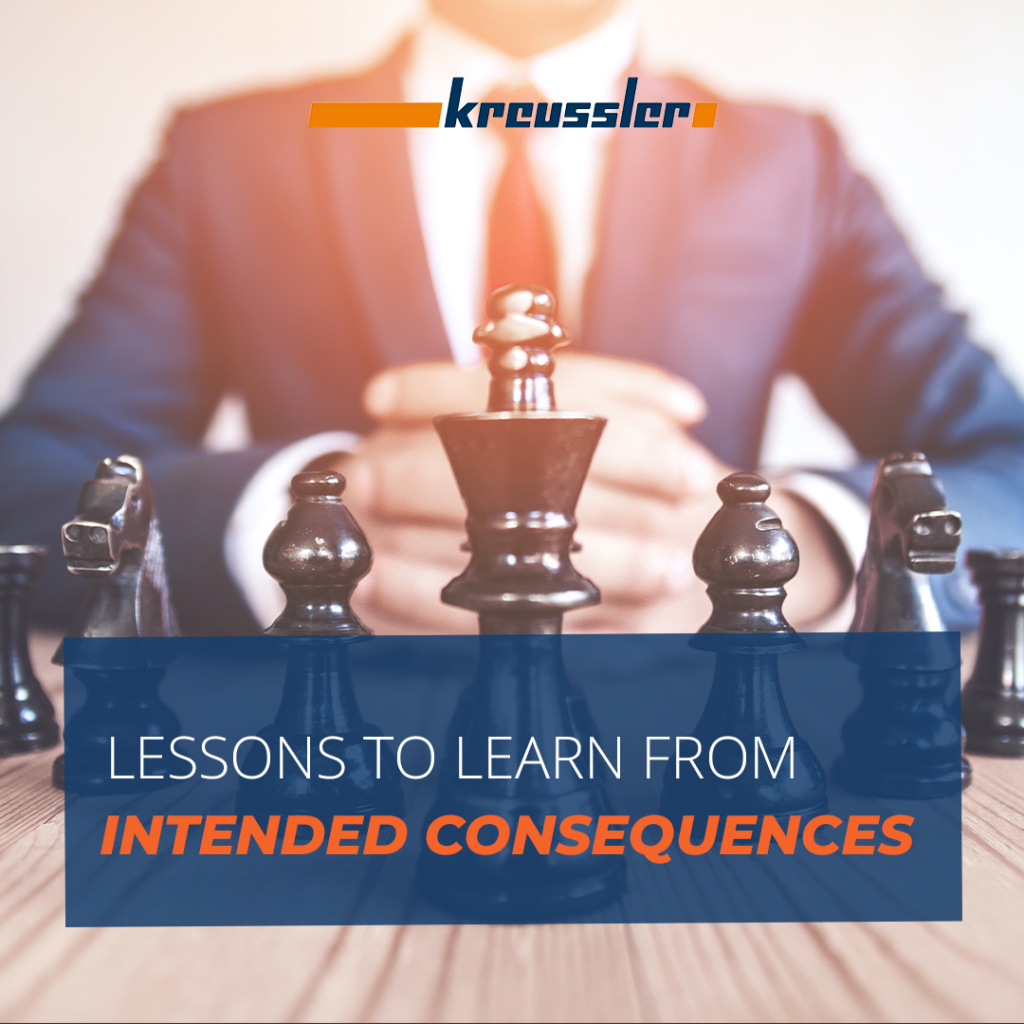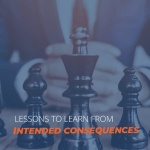When we make decisions, we normally create and implement a plan to push the world in a specific direction, presumably favorable to us. We envision that our strategy, whatever it is, will accomplish some positive set of goals we have set. These are what I call “intended consequences.” We see something that we want, and we act to get it. We operate with intention.
Allow me to provide a simple example. In the dry-cleaning business, we may have a goal of increasing our sales. The idea is that if we raise our piece counts, we increase our profits as well. Those two ideas go hand in hand.
To implement our goal, we start a program of discounts. We offer a 40% discount on clothes brought into our stores from 10:00 AM until 3:00 PM. See how clever that is? Most of our store traffic occurs during morning and afternoon drive times. If we offer a big discount in the middle of the day, we won’t negatively affect our drive time traffic, but we will increase our mid-day traffic. We can increase our overall number of pieces, which we all know is more profitable because the people and the equipment in our organization are already in place and ready to roll for those extra pieces. The overall cost of producing additional pieces at the end of the day is insignificant compared to the cost of producing pieces first thing in the morning, saving us even more money. Win / win / win.
The sale we stage is an enormous success seemingly. Traffic during the middle of the day increased dramatically. Piece counts go up significantly. Positive word of mouth attention of our company is at an unparalleled level fulfilling our stated goal of guerilla marketing. Everyone seems to be talking about our sale. At first, the staff is more productive and working more extended hours, which improves morale. It feels good to us as owners to see the plant busily humming along. Mission accomplished.
Then we get the report card on our performance for the previous month. Sales go up 26.5%, but profits fall 17%. We are crushed at this result and mystified. What went wrong after we had worked so hard?
The answer is that the law of unintended consequences is more powerful by far than the law of intended consequences. In this simple case study, the volume went up, but staff productivity went down in ways we did not anticipate, but probably should have. It turns out; we were not prepared to handle the volume of work our sale produced. Systems broke down. The deal also attracted clothes we were not accustomed to cleaning and were not trained for. As a result, claims went up significantly as the staff washed dry clean only items and dry- cleaned items meant only to be wet cleaned. Production workers became tired, frustrated and sloppy. The bottlenecks in our assembly area that we intended to address became acute under the weight of the additional work. There were even overtime hours to sort it all out. Ouch.
In addition, dependable drive time business atrophied during and immediately after the sale. Loyal morning and afternoon clients felt put out by paying full price when brand new clients coming in the middle of the day were given a substantial discount. That didn’t seem fair to them. This caused client resentment and even anger, which had not been foreseen. Finally, the new clients that the sale did attract turned out to be one-and-done clients who had driven out of their way to take advantage of the significant discount. They never had any intention of becoming regular clients. So instead of helping ourselves as we had intended, we created a self-inflicted disaster driven by unintended consequences.
England and King George III, did everything possible to antagonize even their most loyal subjects in America in the 1770s with the goal of increasing revenues to their domestic treasury. The result: Spent a lot more money than they made; Lost an entire continent; Thousands died. Being more wrong than that is hard. Even the best organization does it. Remember when Coca Cola abandoned the original formula for new Coke? They couldn’t see that public relations and marketing disaster coming? How about when IBM abandoned Microsoft Windows because it was outside their mainframe lane? Talk about unintended consequences.
What’s the alternative? Is there a realistic alternative? How do we compensate for that which we do not, and indeed cannot, know?
When you are making important decisions, when you are making long term plans, do not only ask yourself how your plans are going to succeed. Ask yourself also, how is your project going to unravel? Also, do not allow the team helping you plan to assume that things are going to turn out well as you expect. Follow this kind of process instead.
Start by listing all the Intended consequences of your plan. These are the easy assumptions and will readily come to mind. In fact, because of something called confirmation bias, your whole team is going to be offering their ideas on how well your collective plan will succeed. All your team’s assumptions will become positive. Your team members will re-enforce each other’s views even if they are not worthy ones. You can build tremendous enthusiasm for any plan this way, no matter how bad. Even the possibility of adverse outcomes will become increasingly remote in your mind, and alien in the mind of your team, and therefore in your overall planning scheme.
“Interest rates will go down. The economy will stay strong. My wife and children won’t miss me at night and on the weekends. My core business will continue to grow at its regular rate of 8%. If we build it, they will come. The world is clamoring for a nouveau cuisine blending Mexican, Chinese, and Indian dishes. The takeout profits alone are going to justify the investment.” We’ve all been here, right?
Here is an alternative: after you have created this easy list of intended consequences, begin to challenge your assumptions. Do it with purpose. Do not plan on everything going as expected. Visualize how the plan might fail. Imagine the roadblocks. Create scenarios wherein the timing of your project is unrealized. Remove a key player. Imagine an illness or an accident. Force your team to see the downside to every intended consequence. Do this alternative reality planning in a committed, organized, disciplined way. Commit it to paper. Excel is perfect for this kind of exercise. Remember, if it is not written down; it’s not effective!
Some may view this process as being negative or as stifling creativity. Why be so pessimistic? You might argue that such a process would prevent any plan from working, no matter how good. The future is not clear, and searching for certainty is useless, so why try?
It is somewhat true. If we knew all that was going to happen to us, we might never get married or have children; we would likely not own our businesses. In life, we must rely on being adaptable. We must be tough-minded. We must be determined. We know there is going to be adversity. As they say, fail fast and fail often. We can surely overcome any obstacles. Moreover, we can only make decisions based on what we know, and we must fight with the army we have. I get that.
However, I am also sure that if the intended consequences of our actions equal 100, then the unintended consequences of our actions equals 1,000. Best to be aware of that. I urge you to embrace this reality wholeheartedly.
Find a way to explore the 1,000. Be serious about it. Don’t just plan to succeed. Imagine how you might fail so that you can succeed in fact. Force yourself to explore both sides of the coin. At least try to see around the corner. Resist too much enthusiasm for your plan. Fight the confirmation bias that is sure to flow all around you.
“Life is like the sea. Slow to reward effort and aptitude; quick to sink the unfit.” Don’t just plan for sunny days and calm seas. Instead, prepare yourself with many computations; for severe weather, fatigue, illness, for broken equipment and tough circumstances. If you prepare for the inevitable storms that life imposes, then and only then can you safely reach a distant shore, and see your plans realized as you intend.
Sun Tzu wrote about this phenomenon twenty-five centuries ago in The Art of War. He said:
Those who triumph,
compute at their headquarters
a great number of factors
prior to a challenge.
Those who are defeated,
compute at their headquarters
a small number of factors
prior to a challenge.
Much computation brings triumph.
Little computation brings defeat.
How much more so with no computation at all!
By observing only this,
I can see triumph or defeat.



